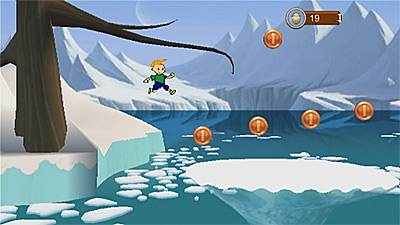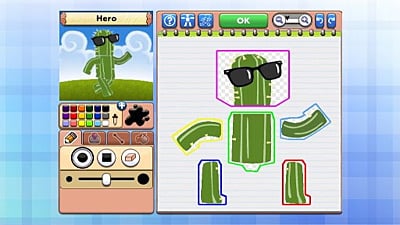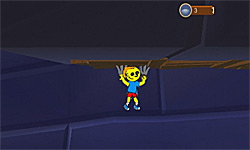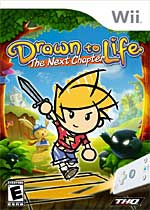Late in Drawn To Life: The Next Chapter, your character gains the ability to use wings in order to glide and perform a more powerful double jump. This was hardly original-save for the fact that I was able to design just how said wings would look-but it was also par for the course with my experience here. So far, I had seen the game borrow and steal liberally from Donkey Kong Country, Sonic and Knuckles, Super Ghouls ‘N Ghosts, LittleBigPlanet, and any number of other 2D platfomers, but when I first used the wings, I was still a bit surprised.
“My god,” I thought to myself. “They even stole from Kratos.”

Platformers are one thing, because who the hell really makes a decent platformer anymore, aside from Nintendo and a few stragglers?-but these wings bared a strong resemblance to ones the Ghost of Sparta used in latter part of God of War II. Or how Alucard’s leap-stone-equipped double-jump looked in Castlevania: Symphony of the Night, if you prefer. It’s sad when a game that purports creativity (even on a very basic and somewhat questionable level, as seen here) is seemingly thrown together from a mish-mash of every platformer design cliché in the book, but, well, DTL Wii isn’t far off this mark.
I should’ve known something was up right from the game’s start. I was asked to draw the game’s world, the sun, and the moon before I had a chance to create my character; the end result for all three were flat, ugly, two-dimensional eyesores that clashed horribly with the game’s colorful, polygonal world. This wouldn’t necessarily be a big problem, but the game gives you such limited tools in which to expand on your creations, however detailed you decide to make them, that there’s really no practical way to make anything you do blend well with its surroundings. I don’t care if the Wii is underpowered-your “artist’s studio” is little more than a glorified recreation of Kid Pix, (yeah, I went there), and in an era of games with such robust creative toolsets as LBP or the upcoming (and meticulously detailed) Mod Nation Racers, that’s pretty unacceptable.

DTL Wii seems content to do what so many sequels do-take an established formula, tweak it a little, and release it. The problem is, the idea behind DTL’s original formula was flawed to begin with. Rather than giving you full creative control over your creations, DTL Wii relegates you to set designer about 80 percent of the time, filling in objects in the world that make it “your own”. You do get to create your own avatar, though not your own enemies or NPCs, and character creation suffers from the artistic shortcomings as the rest. What isn’t allowed is any sort of creative integration, or as is the case with the levels, placement.
The game suggests that you draw, say, leaves falling in a forest, or maybe the nose on a snowman. But what happens if you for some reason don’t? I’ll tell you what happens: there are blank, dotted squares in pre-programmed places in a level, like an undecorated sticker book. So right off the bat, most of the drawing available in the game is completely pointless, and has no bearing on anything actually needed to get through a given level aside from lending a likely-unappealing aesthetic signature to the environment you’re in. I’ll admit that it can be fun to populate a level (or hub town) with whatever the hell you want without either the ESRB or THQ’s online police practicing censorship, but any enjoyment you may get out of this is fleeting and hardly worth devoting a good chunk of what could’ve been an interesting mechanic, too.

Aside from pre-made set dressing, you do get to draw a substantive array of typical platformer obstacles and objects (walkways, seesaws, buttons, rotating devices, and the like), but again, there’s no real sense of creation or accomplishment, as it’s all been pre-placed and can’t be adjusted in any way, aside from cosmetically. Granted, DTL Wii isn’t necessarily going for the jugular of a design-sense like LBP’s, but would it have hurt to thrown in at least some choice for where objects can be placed?
I suppose that’s what they would call the numerous dotted boxes around the game world you create real-time drawings in to get through levels. Of the three box types, drawing in a red box produces an object that reacts to physics and gravity, blue makes stationary objects, which are usually used as makeshift platforms to jump on, and green creates a surface you can bounce on.

Again, any creativity that might’ve been is stifled, as you only have a limited supply of spray to draw with. From a design perspective, this makes sense; objects can only be the size of their boundary-box, driving you to act judiciously when approaching how to get past an area. But it also backfires in a terrible way: without creative control, you will literally just be drawing lines and simple shapes (to either jump on or move, generally), and because these in-level canvases are puzzles linked to level progression, you will be stuck in an area until you draw the necessary components to get past it. If the developers are going to force you to play with their level blueprints, then what exactly is the point of having to draw in big parts of the level yourself? It’s like the dev team just became lazy and decided to have the player draw in their own exit strategy, when it would’ve actually been faster to have the dev team finish the level themselves and utilize the drawing mechanic elsewhere.
Bottom line is this process brings any kind of fluid or graceful progression to a grinding halt. Worse, it makes the game unbelievably tedious. There’s just too much uninteresting drawing. At the start of each of DTL Wii’s four worlds, you get to draw a new ability-based object (non-transferable to other worlds) for your character, such as a monkey tail that lets you perform 360-degree platforming, or claws for climbing up walls. After that, there’s god knows how many objects to draw in and god knows how many more to populate levels with for fun. Considering there’s a brief-ish loading screen for every canvas you bring to life, this slows down the already huge levels.
Add in all the extra, on the fly drawing you have to do using the in-level canvas boxes and it slows your progress to a crawl. Most levels take upwards of twenty minutes to finish, and while there’s only six per world, that’s just too long per level. The platforming itself is decent enough (if entirely forgettable) but DTL Wii’s pacing is so poor that it destroys any momentum that even cliché design has the potential to bring to a game. My personal revenge against the game’s tedium was the pleasure I took in simply spelling out the names of objects when I was instructed to draw pictures of them-sadly, on a platform that already has Super Mario Galaxy, New Super Mario Bros., Klonoa, and the more puzzle-oriented A Boy and His Blob, this kind of enjoyment might be the only DTL Wii can really muster.
RATING OUT OF 5 RATING DESCRIPTION 4.3 Graphics
DTL Wii’s graphics resemble a mix of Klonoa and other colorful polygonal platfomers, with a dash of LBP. It doesn’t look half-bad. 3.5 Control
Controls are fine, if unnoticeable. Switching between canvas boxes isn’t done all that intuitively. 3.0 Music / Sound FX / Voice Acting
DTL’s music and sound are as forgettable as the gameplay. There’s no voice acting. Meh. 1.5
Play Value
Dull, tedious, repetitive. Any sense of creativity seems largely wasted.
2.0 Overall Rating – Poor
Not an average. See Rating legend above for a final score breakdown.
Game Features:
